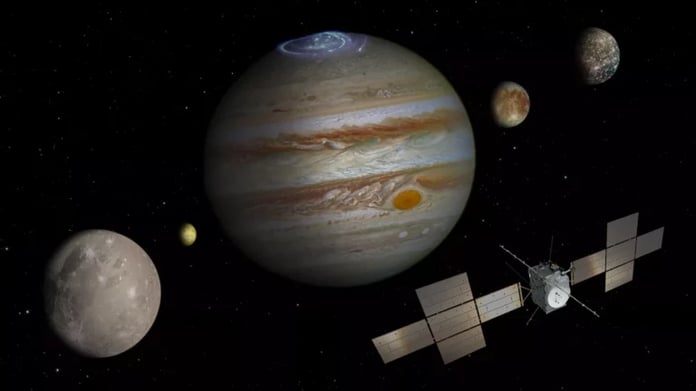From the Kourou cosmodrome in French Guiana, the European interplanetary device JUICE was launched, which will fly to Jupiter only after 8 years. Initially, the launch was scheduled for Thursday, but it was pushed back a day due to the risk of a lightning strike on the rocket. This flagship mission is designed to study the planet’s icy moons and possibly find traces of life in their subglacial oceans.
The European Space Agency decided to send a mission to explore the icy satellites of Jupiter Jupiter Ice Moons Explorer (JUICE) in 2012, when, based on data from NASA’s Galileo and Cassini science devices, it became clear that some of the moons of Jupiter and Saturn are covered in a shell of ice and have a high probability of deep subglacial water oceans in which life can exist.
“The next logical step would be to fly to Jupiter with advanced instruments to study these oceans in detail. With this thought, we wanted to know if there could be life there,” explained Nicholas Altobelli, a member of the European Space Agency mission.
With a mass of six tons, JUICE is the largest mission ever sent by ESA to deep space, and one of the largest ever sent by any country to the outer planets of the solar system. Previously, the Europeans have already launched their probes into deep space – in 2014, the whole world saw the landing of their Rosetta device on the surface of a comet, and the Huygens device, delivered to the Saturn system, landed on its Titan satellite.
JUICE measures 4.09 x 2.86 x 4.35 meters, with most of its mass being fuel (3.65 tons).
The JUICE mission, worth around 1.5 billion euros, is among the flagship L-class missions, designed for many years of operation. The launch of the device, built by Airbus Defense & Space, was postponed only once, and a few months before the launch it was delivered to the cosmodrome by the Ukrainian cargo plane An-124 Ruslan. The large mass of the device dictates the need for a complex trajectory, since the Ariane 5 rocket is not able to bring this cargo directly to Jupiter. Therefore, in order to acquire the necessary speed, after its launch it will perform three gravitational maneuvers near the Earth and Venus and will reach the orbit of the giant planet only in 2031.
ESA/ADS
The device will receive the first additional boost upon returning to Earth in August 2024, and such a maneuver, Lunar-Earth Gravity Assist (LEGA), in which the Moon’s gravity will also be used, will be performed for the first time. in the history of astronautics. “The first maneuver will be very difficult because we have to fly over the Earth and the Moon at the same time. Therefore, the maneuver will be the most precise of all ever carried out”, explained Alessandro Atzey, representative of the ESA.
Additionally, mission engineers allow a gravitational maneuver near asteroid 223 Rosa on the final leg of the flight.
Arriving at Jupiter in July 2031, the spacecraft will perform a detailed survey of its three satellites – Ganymede, Callisto and Europa, around which it will perform at least 35 close flybys. During flights over Europe, the device will try to find “pockets” of liquid water under its icy surface. It will also try to find previously seen jets of water beating below the surface of the satellite.
During 21 flybys over Callisto, the spacecraft explores its cratered surface, which may also hide the ocean. However, the main target will be Ganymede, into whose orbit the device is expected to enter in December 2034. There, the mission will explore the subglacial ocean, the ice shell, the composition and the geological activity of the moon of Jupiter. The probe will study it until 2035, after which it will use the remaining fuel to de-orbit and fall to the surface of Ganymede, which will mean the end of the mission. However, the fall on the satellite can be canceled if the direction of the mission considers that the machine can pollute the subglacial ocean with its debris.
Interest in Ganymede on the part of scientists is dictated by the fact that it is the largest satellite of the planets of the solar system, and the only one capable of generating its own magnetic field. Its diameter is almost 5270 km, which is 8% more than the diameter of the planet Mercury.
The main task of the mission will be to search for habitable conditions on Jupiter’s moons, but not the search for life itself, ESA noted.
“We do not intend to find life with JUICE. We plan to explore interesting aspects related to life and habitability. And in particular, the question of water vapor in satellite atmospheres very low,” explained ESA mission member Oliver Witass.
“It’s one of the most exciting missions ever sent to explore the solar system. And much more complicated,” says ESA chief Josef Aschbacher.
ESA said scientists from 23 countries, 18 research institutes and 83 private companies worked to create the mission and launch it – nearly 2,000 people in total.
On board JUICE are 10 scientific instruments created with the participation of scientists from ESA, NASA, Japanese and Italian space agencies. Among them are the Gravity and Geophysics of Jupiter and Galilean Moons instrument to study the gravitational field and volume of the subglacial oceans of Ganymede and the other two moons, the RIME radar capable of penetrating under the ice, and the JANUS camera to capture the cloud structure of Jupiter itself and the processes occurring nearby.
Many of the spacecraft’s science instruments are sensitive to the magnetic field, so it was decided to place them on a 10-meter retractable rod.
Read the Latest Ukraine War News on The Eastern Herald.


